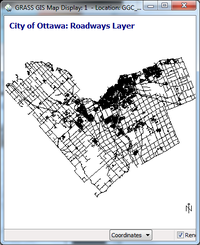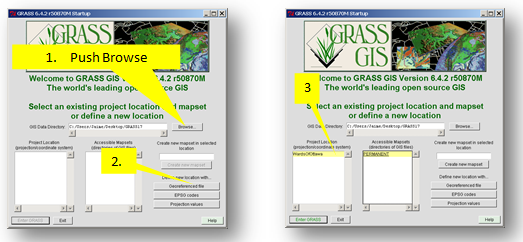Difference between revisions of "Traveling Salesman Problem (TSP)"
(→Data) |
|||
| Line 117: | Line 117: | ||
== '''Data''' == |
== '''Data''' == |
||
| − | Go to [http://app06.ottawa.ca/en/city_hall/statisticsdata/opendata/info/ The city of Ottawa, Open Data Site] |
+ | *Go to [http://app06.ottawa.ca/en/city_hall/statisticsdata/opendata/info/ The city of Ottawa, Open Data Site] |
| + | *Download the .csv file Address Points (main) [http://app06.ottawa.ca/cs/groups/content/@webottawa/documents/pdf/mdaw/mjky/~edisp/cap297201.zip Or click this link.] ''Note: When you unzip this file change its name to customers.csv.'' While at the same site download the Roadways.shp file and the wards2010.shp file too. |
||
== '''Conclusion''' == |
== '''Conclusion''' == |
||
Revision as of 09:05, 21 December 2012
Contents
Introduction
This is a Free and Open Source Software for Geospatial (FOSS4G) inspired tutorial. It focuses on Network Analysis using a Geographic Resources Analysis Support System (GRASS).
About the Tutorial
This tutorials' main aim is to be clear and understandable. I made every effort to use real data even though this presents many problems. However, it is a reality that data is dirty and software is faliable. This tutorial will be very time consuming to complete, however, you will learn alot along the way and this knowledge will easily transfer to future projects.
In this tutorial you will
- Install GRASS
- Download and prepare data
- Start a GRASS database
- Build a network and perform analysis on it
Note If the command line is not working and you don’t wish to take the time to troubleshoot this problem I have been given a great work around from my teacher Scott Mitchell. If you do not have GRASS folders set up refer to step named Getting on our way.
- 1. Launch the OSGeo4W
- 2. Type grass64 –gui and then hit enter on the keyboard. (notice there is a space between 64 and the dash)
- 3. You will see the old GRASS version load, so simply click File from the menu bar and click Quit GIS Manager.
- 4. Now in the command box type g.gui gui=wxpython&
Installation
Install OSGEO Package (30-60mins)
First, you will need to install free geospatial software. I am using GRASS 6.4.2. This can be found through the secure and trusted site of Open Source Geospatial Foundation OSGeo4w is Your Open Source Compass for Windows This package provides a set of open source geospatial software for a Win32 environment. Simply follow the directions from this site: Click Here to go to Download Page
Launch GRASS(1-1.5 hrs)
Launching GRASS Tutorial This tutorial will give you a simple walk through of GRASS allowing for an increased understanding of the software, though it is not necessary to complete it in full.
The Tutorial
GRASS Database (just minutes)
1. Prior to starting a GRASS session, create a New Folder named Grassdata and a second named nonGrassData. Start GRASS and once the screen opens, browse to the Grassdata folder. Ensure all file and folder names contain NO spaces, that they are short, and do not begin with numbers.
2. Push the button for Georeferenced files, name the newLocation Ottawa and then browse to the nonGrassData folder. Select the Roadways.shp file. Now click define.
3. Click on both Ottawa and then PERMANENT in each of the grey boxes and then push the ENTER GRASS button. Now we are ready to start working in GRASS.
Import data files and prepare them for processing and analysis
Importing .shp
1. You now have three screens open and running under GRASS. A command line black box, a GRASS GIS Layer Manager, and a Map Display pane. In the Layer Manager window click File | Import Vector Data |Common Import Formats.
2. A GUI window will appear to lead you forward. Choose Roadways.shp from the drop down menu and push Run. If you watch the Layer Manager window it will tell you when all is complete. At the bottom of the window you will have to hit the Map Layers tab as you have been watching the command console tab.
3. Now the Roadways.shp file is loaded to the Layer Manager window simply toggle it on to view it in the Map Display window.
Next do the same for the wards.shp file.
Importing .csv
This is not as straight forward as the .shp files. You must first open the Addresses.csv file in OpenOffice Calc for editing.
Type this in the command line box, it will adjust the region parameters.
g.region -p vect=Roadways
Next extract the location you specifically wish to focus on. In this case it will be the Somerset ward.
v.extract input=Wards_2010 output=Somerset type=area where=cat=16
Next extract the customers that are within that ward from the larger customer data set.
v.select ainput=Addresses@Try1 atype=point binput=Somerset@Try1 btype=area output=addSomerset operator=within
Next extract the Roadways
v.overlay ainput=Roadways@Try1 atype=line binput=Somerset@Try1 output=SomerRoads operator=and
Network Preperation
Type this in the command line box, it will adjust the region parameters.
g.region -p vect=Somerset
Next clean the data
v.clean input=SomerRoads output=SomerRoadCl type=line tool=break,rmdupl
Extract a Start point. When you right click on the addSomerset layer in the Layer Manager window, select to veiw the Attribute table. Scroll to find the exact address you want to use and note its 'cat#.' you will interchange that number with the 444 I have in the code below.
v.extract input=addSomerset output=StartPt type=point where=cat=444
We know that the homes are not located directly on top of the roads so we must calculate and attach them to the network for processing and analysis. First we will create 3 new columns in the attribute tables and then populate them.
v.db.addcol map=addSomerset columns='x double precision,y double precision,dist int'
v.db.addcol map=Start columns='x double precision,y double precision,dist int'
v.to.db map=Start type=point option=coor columns=x,y
v.to.db map=addSomerset type=point option=coor columns=x,y
v.distance from=Start to=SomerRoadCl to_type=line upload=dist column=dist
v.distance from=addSomerset to=SomerRoadCl to_type=line upload=dist column=dist
Once we have the distance from all points to the roads,connect all the addresses to the road-network according to a threshold (distance)
v.net input=SomerRoadCl points=Start output=network_S operation=connect thresh=10
v.net input=network_S points=addSomerset output=net_S operation=connect thresh=50
Note: If the program crashes after the last input, as mine did, try repeating the cleaning step (v.clean) on the network_S file prior to running the next step on it. You will notice that my new file is named clNetwork with the output file being TheNetwork.
v.clean input=network_S output=clNetwork type= line tool=break,rmdupl
we can view information about the network
v.category TheNetwork op=report
Network Analysis Examples
Shortest path, no cost
We have a start point, now it is time to choose a destination. Once again choose the 'cat#' of an address point, as you did earlier, using the attribute table from addSomerset.
v.extract input=addSomerset@Try1 output=EndPt type=point where=cat=44592
file:///C:/OSGeo4W/apps/grass/grass-6.4.2/docs/html/v.net.path.html
how do i type this?
Data
- Go to The city of Ottawa, Open Data Site
- Download the .csv file Address Points (main) Or click this link. Note: When you unzip this file change its name to customers.csv. While at the same site download the Roadways.shp file and the wards2010.shp file too.
Conclusion
Contributions to This Tutorial
About This Tutorial
This tutorial was created for GEOM4008 which is part of the Geomatics program at Carleton University, located in Ottawa, Ontario, Canada.
External Links
Here is a list of links that offer additional support and information;
- Quantum GIS Web site
- Quantum GIS Wiki
- Grass GIS Web site
- Grass GIS Wiki
- Spatial Reference
References
Data





